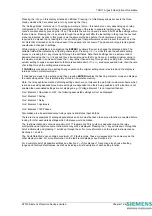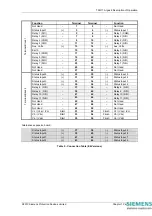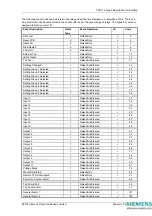
7SG11 Argus 8 Description of Operation
Pressing the key on this display initiates an LED test. Pressing at this display allows access to the three
display modes which are accessed in turn by pressing the key.
The ‘Settings Mode’ contains up to 10 setting sub-menu’s. (Note :- this number can vary depending upon relay
configuration). These hold all of the programmable settings of the relay in separate logical groups. The sub
menu’s are accessed by pressing the key. This enters the sub menu and presents a list of all the settings within
that sub menu. Pressing the key scrolls through the settings until after the last setting in the group the next sub
menu is presented. Access to this group is via the same method as before. If a particular sub menu is not
required to be viewed then pressing the key will skip past that particular menu and present the next one in the
list. Note that all screens can be viewed even if the password is not known. The password only protects against
unauthorised changes to settings.
While viewing an editable screen pressing the
ENTER
key allows the user to change the displayed data. The
editable field will be indicated by a flashing character(s). Pressing or scrolls through the available setting
values or, pressing the key moves right through the edit fields. Note that all settings can be incremented or
decremented using the or keys and they all wrap-around so that to go from e.g. a setting minimum value to
the maximum value it is quicker to press the key, rather than scroll up through every setting. Also, to facilitate
quicker setting changes an acceleration feature is available which if or are depressed and held, then the rate
of scrolling through the setting values increases.
If
CANCEL
is pressed during a setting change operation the original setting value is restored and the display is
returned to the normal view mode.
If changes are made to the setting value then pressing
ENTER
disables the flashing character mode and displays
the new setting value. This is immediately stored in non-volatile memory.
Note : the relay exhibits a method of hiding settings which are not relevant to a particular customer scheme which
is known as setting dependencies. Some settings are dependant on others being enabled and if a function is not
enabled then associated settings are not displayed e.g. if Voltage Element 1 is not required then set,
Gn V Element 1 Operation to OFF ; the following associated settings will not be displayed ;
Gn V Element 1 Setting,
Gn V Element 1 Delay,
Gn V Element 1 Hysteresis,
Gn V Element 1 O/P Phases,
Also hidden are all associated output relays options and status input inhibits.
There are many examples of setting dependencies and care must be taken to ensure a function is enabled before
looking for other associated settings which otherwise would be hidden.
The ‘Instruments Mode’ contains a maximum of 17 instruments. This number is dependent upon the relay
configuration and therefore some instruments may not be displayed. Pressing the key scrolls down through the
list of instruments and pressing scrolls up through them. For more information on the relay’s instruments see
Sections 4.1 and 4.5.
The ‘Fault Data Mode’ can contain a maximum of 10 fault records. These are accessed in the same way as the
other display modes. For more information on the fault record displays see Section 4.2.3.
For a complete list of all possible settings see Section 3 – of this manual. This section also shows all setting
ranges and factory default values, as well as including a brief description of each setting function.
©2010 Siemens Protection Devices Limited
Chapter 1 Page 15 of 20
















































